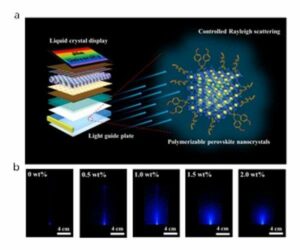Size Matters: Carbon nanotube diameter influences photodetector efficiency
by Simon Mansfield
Sydney, Australia (SPX) Aug 01, 2023
Scientists at Tsinghua University and the Chinese Academy of Sciences have discovered that changes in the diameter of single-wall carbon nanotubes (SWCNTs) can drastically improve the optoelectronic performance of photodetector heterojunctions with perovskite quantum dots (QDs).
Photodetector heterojunctions work by utilizing the interaction between two different materials to convert light into electricity. In this case, the materials are SWCNTs – cylindrical structures composed of a single layer of carbon atoms – and CsPbBr3 perovskite quantum dots, a photovoltaic substance that generates an electric current when exposed to sunlight and paired with an appropriate material like SWCNTs.
The research team, led by Professor Huaping Liu of the Institute of Physics at the Chinese Academy of Sciences, found that the diameter of the SWCNTs plays a critical role in the performance of the heterojunctions. They systematically varied the diameters of SWCNTs within the heterojunction films, noting significant improvements in responsivity, detectivity, and response time as the diameter increased.
“Our findings suggest that the enhanced separation and transport of photogenerated excitons, neutral particles that are responsible for carrying energy, in the film could be attributed to the larger diameter of SWCNTs,” Liu said. The team believes this is due to the alignment of the band gaps of the SWCNTs and QDs, which are the energy differences that allow an electron to conduct an electric current.
The researchers observed these effects in SWCNT diameters between 1.0 and 1.4 nm, with SWCNT band gaps inversely related to their diameter. As the diameter of the SWCNTs increased, there was an approximately tenfold increase in responsivity, a fivefold increase in detectivity, and a fourfold increase in response speed. “The larger-diameter SWCNTs clearly demonstrated improved carrier capacity and mobility, which boosted film performance,” said Liu.
The implications of this study are substantial, particularly for the design of future high-performance photodetectors. Such photodetectors will be crucial for various applications, including optical communications, wearable technologies, medicine, and artificial intelligence. The cost-effectiveness, energy efficiency, and robustness of SWCNT and QD-based photodetectors will be particularly advantageous for these applications.
Surprisingly, while SWCNT monolayer films are typically inefficient at detecting light and perovskite QD films have limitations in terms of carrier mobility, responsivity, and detectivity, pairing them results in improved optical absorption and responsivity.
Liu’s team aims to apply the findings from this study in the design of optimized photodetectors for use in sensitive artificial vision systems, further demonstrating the potential impact of this research on the development of next-generation technology.
Research Report:Diameter-dependent photoelectric performances of semiconducting carbon nanotubes/perovskite heterojunctions
Related Links
Tsinghua University
Carbon Worlds – where graphite, diamond, amorphous, fullerenes meet
- SEO Powered Content & PR Distribution. Get Amplified Today.
- PlatoData.Network Vertical Generative Ai. Empower Yourself. Access Here.
- PlatoAiStream. Web3 Intelligence. Knowledge Amplified. Access Here.
- PlatoESG. Automotive / EVs, Carbon, CleanTech, Energy, Environment, Solar, Waste Management. Access Here.
- BlockOffsets. Modernizing Environmental Offset Ownership. Access Here.
- Source: https://www.spacedaily.com/reports/Size_Matters_Carbon_nanotube_diameter_influences_photodetector_efficiency_999.html
- :is
- :where
- 1
- 180
- 2023
- a
- Academy
- advantageous
- aims
- allow
- an
- and
- applications
- Apply
- appropriate
- approximately
- ARE
- artificial
- artificial intelligence
- AS
- At
- Aug
- Australia
- BAND
- BE
- believes
- between
- Boosted
- by
- CAN
- Capacity
- carbon
- carbon nanotubes
- carrying
- case
- Changes
- chinese
- clearly
- COM
- commercial
- Communications
- composed
- Conduct
- convert
- could
- critical
- crucial
- Current
- demonstrated
- demonstrating
- Design
- Development
- Diamond
- differences
- different
- discovered
- drastically
- due
- effects
- efficiency
- Electric
- electricity
- energy
- energy efficiency
- enhanced
- Ether (ETH)
- Expo
- exposed
- Film
- films
- findings
- For
- found
- from
- further
- future
- gaps
- generates
- Have
- high-performance
- Highlight
- HTML
- http
- HTTPS
- Impact
- implications
- improve
- improved
- improvements
- in
- Including
- Increase
- increased
- inefficient
- Institute
- Intelligence
- interaction
- into
- jpg
- larger
- LAS
- Las Vegas
- layer
- Led
- light
- like
- limitations
- material
- materials
- Matters
- medicine
- mobility
- Neutral
- next-generation
- noting
- observed
- of
- on
- optimized
- our
- paired
- pairing
- particularly
- performance
- performances
- Physics
- plato
- Plato Data Intelligence
- PlatoData
- plays
- potential
- Professor
- Quantum
- Quantum dots
- related
- report
- research
- researchers
- response
- responsible
- Results
- robustness
- Role
- s
- Said
- SCIENCES
- scientists
- sensitive
- significant
- Simon
- single
- Size
- speed
- spx
- Study
- substance
- substantial
- such
- suggest
- sunlight
- Systems
- team
- Technologies
- Technology
- terms
- that
- The
- their
- Them
- There.
- These
- they
- this
- time
- to
- transport
- Tsinghua
- two
- typically
- UAV
- university
- use
- Utilizing
- various
- VEGAS
- vision
- vision systems
- was
- wearable
- when
- which
- while
- will
- with
- within
- Work
- world’s
- zephyrnet














